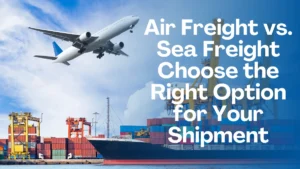When it comes to global shipping, businesses are often faced with one crucial decision: should they choose air freight or sea freight? Each method has its own benefits, costs, and limitations and selecting the right one can significantly impact delivery time, budget, and customer satisfaction. Whether you’re shipping high-value electronics or large industrial cargo, understanding the differences between air and sea freight is essential for a smooth logistics process.
In this guide, we’ll break down the key factors to consider when choosing between air and sea transport. From cost comparisons and delivery times to cargo types, regulations, and environmental impact, you’ll learn which option suits your needs best. Whether you’re exporting from Pakistan or managing international shipments across regions, this article will help you make informed, profitable decisions.

What Is Air Freight? What Is Sea Freight?
What Is Air Freight?
Air freight refers to the transportation of goods by aircraft. It’s the fastest shipping method available, ideal for time-sensitive deliveries such as electronics, pharmaceuticals, or perishable goods. Whether you use dedicated cargo planes or commercial flights, air freight ensures speed, security, and global reach. It’s often used when delivery time is critical or when the shipment is small but high in value.
Air freight costs are typically based on chargeable weight, which considers both actual and dimensional weight. That’s why it becomes costly for bulky items.
What Is Sea Freight?
Sea freight (also called ocean freight) is the process of transporting goods via large cargo ships. It’s more cost-effective for large or heavy shipments, especially when delivery speed isn’t urgent. Sea freight is used for transporting industrial goods, bulk items, and cargo that can withstand longer transit times.
Goods can be shipped as Full Container Load (FCL) or Less-than Container Load (LCL), depending on volume. Though slower, sea freight is more fuel-efficient and has a lower carbon footprint per shipment.
Transit Time
Air Freight: Fastest Delivery Option
Air freight is the best choice when time is of the essence. Shipments typically take 1 to 7 days depending on the route and destination. It’s ideal for urgent deliveries, high-turnover retail items, or perishable goods that cannot endure long transit periods. Air carriers also offer more frequent departures, meaning missed flights cause minimal delays.
In addition, air freight moves directly between airports, often reducing customs delays and providing a more predictable schedule.
Sea Freight: Slower but Steady
Sea freight, on the other hand, generally takes 20 to 45 days depending on the port locations and route. It involves multiple handling stages, including port loading/unloading, customs checks, and sometimes transshipments. Delays due to weather, port congestion, or documentation issues are more common with sea freight.
However, new Expedited LCL and express sea freight options are now available for certain trade lanes. These services narrow the gap between sea and air in terms of delivery times, offering an alternative for medium-priority shipments at lower costs.
Cargo Type and Volume
Air Freight: Best for Lightweight, High-Value Goods
Air freight is ideal for small-volume shipments that are lightweight, time-sensitive, or high in value. Electronics, pharmaceuticals, fashion accessories, and perishable items are commonly shipped by air due to their short shelf life or the need for tight security.
However, air freight comes with weight and dimension limitations, making it unsuitable for bulky or irregularly shaped items. If your goods are light but voluminous, you’ll also pay more due to dimensional weight pricing.
Sea Freight: Ideal for Bulk and Oversized Shipments
Sea freight is the preferred choice for large, heavy, or irregular-shaped cargo. Whether you’re shipping industrial machinery, furniture, or raw materials, container ships can handle significant load volumes with ease. A standard 20-foot container offers around 1,172 cubic feet of space, making it more economical for full container loads (FCL) or less-than-container loads (LCL) when combining with other cargo.
Sea freight also allows for greater flexibility in cargo type, including hazardous materials, as long as they meet port and carrier regulations.
Security and Risk
Air Freight: Higher Security, Lower Risk of Damage
Air freight offers a secure and closely monitored environment for valuable or sensitive shipments. Airports have strict security checks, surveillance systems, and efficient cargo handling procedures, which significantly reduce the risk of theft or damage during transit.
Because air freight involves fewer touchpoints from loading to final delivery, there’s a lower chance of mishandling. That’s why many businesses prefer air shipping for electronics, medical supplies, and luxury items that require extra care.
Sea Freight: Moderate Risk, But Safe with Proper Handling
Sea freight involves multiple handling stages from loading at the port to container transfers and inland transportation, which increases the risk of damage or delays if not managed properly. However, most sea cargo is packed in sealed containers, offering a solid layer of protection against external conditions.
To minimize risks, it’s essential to use reliable freight forwarders, ensure proper packaging, and consider cargo insurance, especially for long-distance sea routes.
Environmental Impact
Sea Freight: The Greener Option for Bulk Shipping
Sea freight is widely regarded as the more environmentally friendly mode of transportation. Ships emit significantly less CO₂ per ton of cargo moved compared to airplanes. For businesses focused on sustainability and reducing their carbon footprint, sea freight is often the preferred choice.
In fact, with innovations like slow steaming and the use of alternative fuels, many carriers are actively working to reduce emissions further. If your business prioritizes green logistics, shipping by sea aligns well with long-term environmental goals.
Air Freight: Faster but with Higher Emissions
While air freight offers speed, it comes with a much higher environmental cost. Aircraft emit up to 40–50 times more CO₂ per kilogram of cargo than ships. This makes air freight less favorable for companies looking to build a sustainable supply chain.
That said, air transport might still be necessary for urgent deliveries, but it’s important to weigh the environmental trade-offs before choosing this option.
Regulations and Restrictions
Air Freight: Stricter Controls and Limitations
Air freight is subject to stringent international regulations, especially when it comes to hazardous materials. Items such as flammable liquids, corrosives, batteries, and magnetic materials often require special handling or are entirely restricted from air transport.
Aviation authorities like IATA (International Air Transport Association) enforce detailed compliance standards. This can add complexity, documentation requirements, and approval delays, especially for sensitive or regulated goods.
Sea Freight: More Flexibility but Still Regulated
Sea freight offers more flexibility in terms of what can be shipped. Bulky items, heavy machinery, and a wider range of dangerous goods are generally allowed, provided they comply with international maritime regulations such as IMO (International Maritime Organization) standards.
Still, sea shipments are not free from red tape. Customs regulations, port-specific rules, and destination country restrictions must be carefully managed—especially when handling LCL shipments or goods passing through multiple ports.
Flexibility and Reliability
Air Freight: High Reliability, Less Flexibility
Air freight is renowned for its schedule reliability and punctuality. With multiple flights daily across global hubs, it offers consistent departure and arrival times—ideal for time-sensitive shipments. Airlines also provide real-time tracking, enabling businesses to monitor shipments closely and plan inventory accurately.
However, air freight lacks flexibility in cargo types and volumes. With strict dimensional limits, it’s not always suitable for large or odd-shaped items. Airlines are also less accommodating when it comes to last-minute changes or rescheduling, especially during peak seasons.
Sea Freight: Flexible but Vulnerable to Disruptions
Sea freight offers much greater flexibility in terms of cargo size, packaging, and shipment customization. Whether it’s Full Container Load (FCL) or Less than Container Load (LCL), businesses can choose shipment options based on their volume and budget.
But when it comes to reliability, sea freight is more susceptible to delays from weather, port congestion, and customs clearance. Unexpected strikes or route blockages (like the Suez Canal incident) can drastically impact timelines. Still, with proper planning and buffer periods, sea freight remains a practical choice for non-urgent shipments.
When to Choose Air Freight vs Sea Freight
Choose Air Freight If:
- Speed is a top priority. Air freight is ideal for urgent shipments such as perishable goods, pharmaceuticals, or time-sensitive electronics.
- You’re shipping high-value or low-volume items. With tight security and less handling, air is safer for fragile or expensive cargo.
- Space is limited. For small but important loads, air cargo ensures quick and reliable delivery, even to remote destinations.
Choose Sea Freight If:
- You’re shipping in bulk. Sea freight suits large volumes, machinery, furniture, or other oversized cargo.
- Budget is a concern. It’s significantly more cost-effective, especially for long-distance or intercontinental shipping.
- Environmental impact matters. Sea freight has a lower carbon footprint, making it the preferred option for eco-conscious brands.
Final Thoughts
Choosing between air freight and sea freight depends on what matters most for your business—speed, budget, cargo type, or sustainability. Air freight offers unmatched speed and security, ideal for high-value, time-sensitive shipments. In contrast, sea freight is more affordable and suitable for large volumes and businesses with flexible timelines.
By understanding the key differences in cost, transit time, cargo capacity, regulations, and environmental impact, you can make better shipping decisions that align with your business goals.
Need expert support? Partner with reliable freight professionals like World Allied Movers to simplify your logistics and expand confidently into global markets.
Need help with international cargo? Contact us today.

